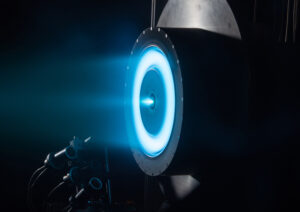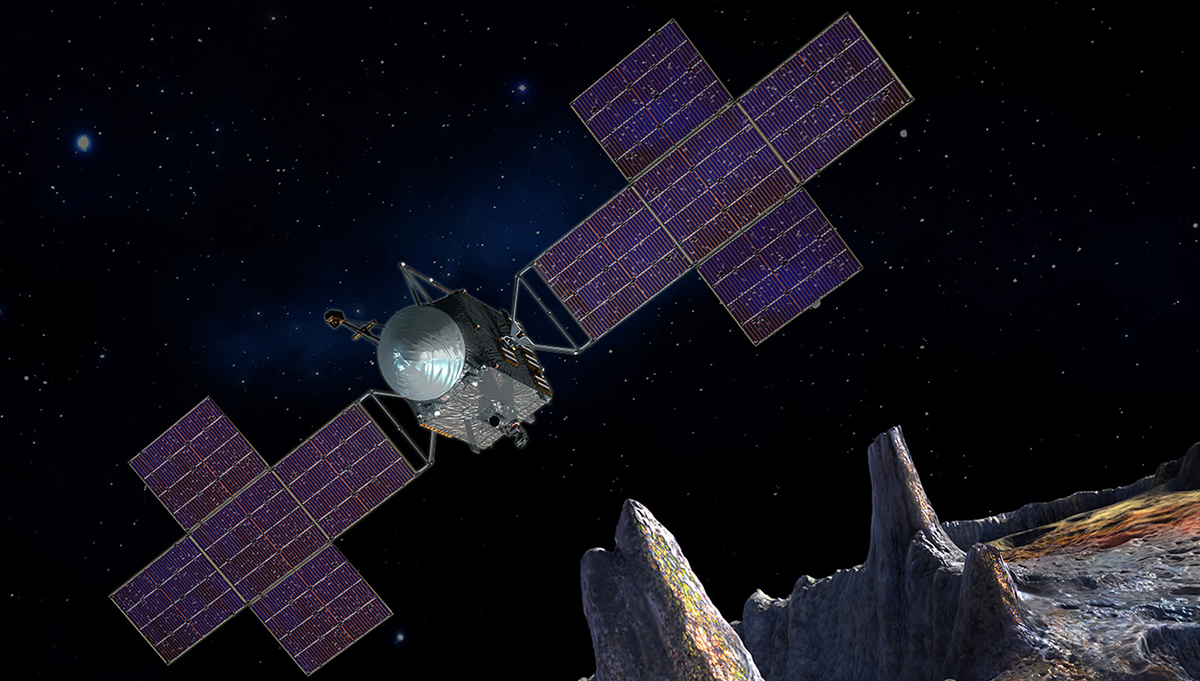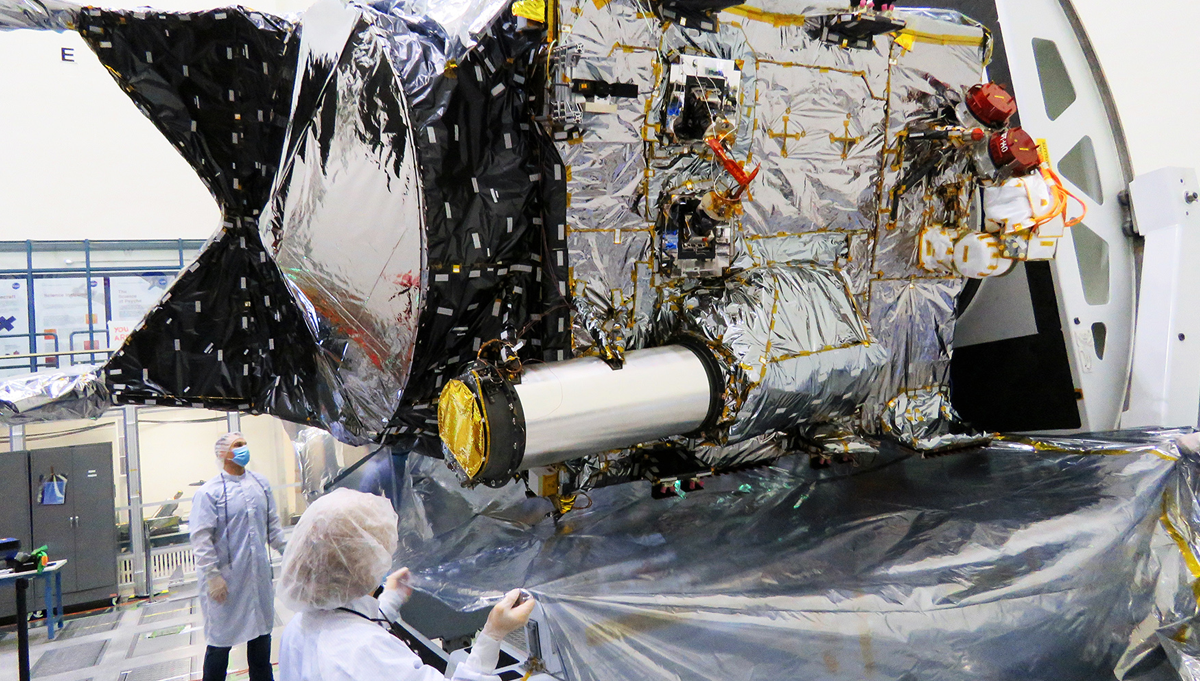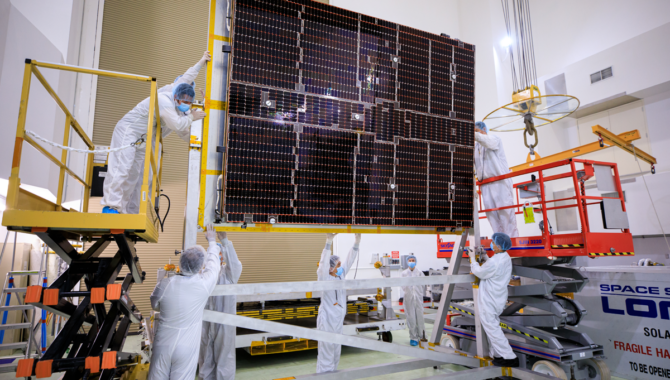
In this image from July 18, 2023, a NASA team helps attach solar arrays for the agency’s Psyche spacecraft onto a stand inside the Astrotech Space Operations Facility near Kennedy Space Center in Florida.
Photo Credits: NASA/Isaac Watson
2.2-billion-mile journey to metal-rich asteroid tests new technology.
The Main Asteroid Belt occupies a vast circle around the Sun in the 550 million kilometers between the orbits of Mars and Jupiter. The belt is sparsely populated with more than 1.3 million known objects, believed to be remnants of the early solar system. The objects range from Ceres, a dwarf planet about 580 miles in diameter, to tens of thousands of asteroids less than one tenth that size. All the known asteroids combined there have less mass than Earth’s Moon.
One of the most intriguing objects is Psyche, the 16th object identified there by early astronomers in the 1850s. At about 140 miles in diameter, Psyche is less than half the size of Vesta, the largest asteroid in the belt. A year on Psyche is approximately five Earth years long, but a day there—one rotation on its horizontal axis—is just over 4 hours.
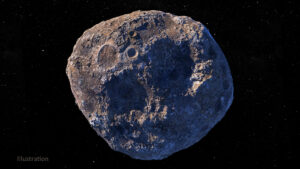
This artist illustration depicts the distant, metal-rich asteroid Psyche, which orbits the Sun in the Main Asteroid Belt between Mars and Jupiter.
Illustration Credits: NASA/JPL-Caltech/ASU
Psyche is by far the largest of less than a dozen known asteroids that appear, based on their mass and radar albedo, to contain significant amounts of metals such as iron and nickel. Psyche’s size and rare composition leads some scientists to suspect that it could be the remnant of a planetesimal core, obliterated as it was forming.
NASA is making final preparations to launch a spacecraft, also named Psyche, on October 5, the first day of a launch window that extends for 21 consecutive days. The launch, the first of SpaceX’s Falcon Heavy Vehicle configuration by NASA, will be the culmination of more than a decade of research, planning, development, and preparation by a dedicated team who worked through the Coronavirus pandemic.
“This is going to be primary exploration. We really don’t know what we’re going to see. … We’re going to learn about, when we get to Psyche, a previously unstudied ingredient that went into making our habitable Earth. And that is the metal that is now in the Earth’s core and the cores of all the rocky planets. Cores that we can never visit, but cores that we want to learn about,” said planetary scientist Lindy Elkins-Tanton, Principal Investigator of the Psyche mission, speaking at a recent NASA press conference.
The spacecraft is 10 ft. high, 7.2 ft. wide and 8 ft. deep with its massive solar arrays stored for launch aboard the rocket. On orbit, the spacecraft will deploy the arrays, with a total of 800 square ft. of solar collecting surface. The spacecraft will use solar arrays to power a type of ion propulsion known as Hall-effect thrusters.
“The way that works is, we collect all this electrical energy, and we use it to ionize xenon gas down into these elemental little particle ions. And then we accelerate those particles to extremely high speeds by passing them through a very strong electromagnetic field, which is part of the thruster itself. And then we eject those out the thruster, basically the thruster nozzle. And that allows us to generate the thrust that we will need to power this vehicle on its 2.2-billion-mile journey to the Psyche asteroid,” said Henry Stone, Psyche Project Manager at NASA’s Jet Propulsion Laboratory.
The spacecraft will travel nearly six years to reach the asteroid, passing Mars for a gravity assist before arriving in August of 2029. Once there, the spacecraft will orbit Psyche at four different altitudes over a 26-month primary mission, gathering data with a suite of instruments that includes a Multispectral Imager, a Gamma Ray and Neutron Spectrometer, a Magnetometer, and an X-band Gravity Science Investigation.
“How do you prepare to study an unknown object? First of all, we’re bringing imagers. We’ve got to know what it looks like. We’ve got to bring our cameras. … We’re going to bring magnetometers because we hope that it has the history of a magnetic field to teach us about when it was a core. … And then we’re going to bring an amazing instrument called the gamma-ray and neutron spectrometer…, which will allow us to measure the surface composition of the asteroid while in orbit,” said Elkins-Tanton.
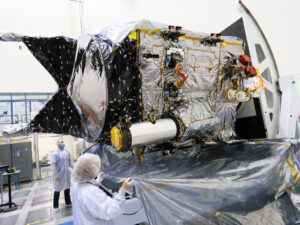
DSOC’s flight transceiver can be identified by its large tube-like sunshade on the Psyche spacecraft, as seen here inside a clean room at JPL.
Photo Credits: NASA/JPL-Caltech
The spacecraft will include a ride along demonstration of the Deep Space Optical Communication (DSOC) system. This will be the first deep space test of optical communications, which promises to dramatically increase transmission bandwidth by sending data via near-infrared laser signals.
“We’re doing this by using a laser beam, which is orders of magnitude higher in frequency than state-of-the-art telecommunication radios,” said Abi Biswas, Project Technologist for DSOC, who noted that Psyche will test the technology at almost 1,000 times the distance of previous demonstrations from the Moon. “Now this huge increase in distance … brings with it new challenges and difficulties. And the DSOC project has developed technologies to overcome these challenges, and to demonstrate a 10 times augmentation of traditional telecom data rates that we get from Mars today, let’s say.”
“So, the pointing of laser beams is very difficult, and that’s one of the main challenges we’re trying to overcome,” Biswas added. The spacecraft will acquire a laser beam transmitted from Earth and use that as a pointing reference to send down its own laser beam to the Palomar Observatory in California. “Just to give you an analogy of how difficult the laser beam pointing is, it’s like aiming at a dime from about a mile away. And that’s why we need this assistance from the ground laser beam, which gives us a stable point of reference to point back to the ground.”
The mission’s science goals include determining if the metal on Psyche shows the signs of melting that would be expected if it is a core, determining the age of Psyche’s surface regions, determining if it incorporates the same elements as are expected in the Earth’s high-pressure core, determining whether Psyche was formed under conditions more oxidizing or more reducing than Earth’s core, and characterizing Psyche’s topography.
“Our original science question was, ‘How did metal cores and rocky exteriors form in the very earliest little planetesimals, baby planets, in our solar system, that went on to add up to become the Earth and our other rocky planets?’ These are things that if the solar system was a 24-hour day, they formed in the first 30 seconds. And so, then we searched where in our solar system can we go find out about this? And we settled on Psyche,” Elkins-Tanton said.
To learn more about Psyche, visit the mission page, or listen to this episode of the Small Steps, Giant Leaps podcast.






